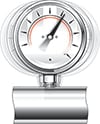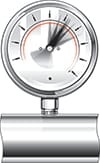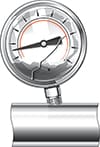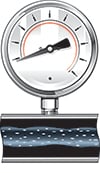: Common Gauge Failures
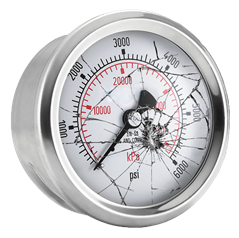
Common Reasons: Why Your Gauges May Be Failing?
Pressure gauges are a critical part of your system, providing a visual indication of the fluid system pressure. Broken gauges lead to bad decisions, and bad decisions lead to process downtime or unexpected accidents.
If you are facing with increasing numbers of gauge failures at your facility? Let Swagelok take the pressure out of you. We can educate and recommend best practices for your gauges in service as well as help you standardize and simplify your gauge
Below is the common reasons for gauge failure and recommended solutions to help avoid the headaches and risks of inaccurate readings.
1. Mechanical Vibration
Vibration is the main cause of pressure gauge failure. Vibration has a negative impact on gauge accuracy in two ways. First, it is difficult to accurately read a pointer on a dial when a gauge is vibrating. Second, incremental damage to the pointer mechanism from vibration can eventually move a pointer off zero, producing inaccurate readings.
Different types of gauges are built to withstand various types and levels of vibrations, and it is critical to use an appropriate, quality gauge for every application. Installing a pressure gauge with low vibration resistance in a high-vibration area is a recipe for trouble.
2. Temperature
Extremely high or low temperatures can have a negative impact on gauges and other instrumentation. Gauges not designed for these extreme operating conditions can malfunction in a relatively short period of time. Some gauges are designed for extreme temperature conditions and will provide reliable information for the lifetime of the instrument.
3. Overpressure
Process media is normally transported through a piping system at relatively high pressure, and gauges appropriate for that pressure are installed for process monitoring. However, when workers switch pumps on or off, or open or close valves, a surge of media flows through the pipe and impacts the pressure gauge, causing a spike which can damage the gauge. The solution to overpressure problems is to use reliable gauges with tolerances several times higher than the standard flow pressure or to install overpressure protectors on gauges in areas where overpressure spikes tend to occur.
4. Pulsation
Pulsation can be defined as regularly occurring overpressure spikes. When media rapidly cycles through the gauge, the pressure spikes intermittently. The most common solutions for pulsation involve installing a socket restrictor or a pressure snubber, which slows down the media by reducing the size of the intake orifice and minimizes pressure fluctuations.
5. Misapplication and Mishandling
Misapplication, or putting in the wrong kind of gauge for an application, is a common problem. For example, if a line is pumping oil at 100 PSI, a non-expert may mistakenly install a 100 PSI gauge, not realizing this leaves no allowance for overpressure, surging, or spiking, and will significantly shorten the lifetime of even a quality gauge.
Gauges can be tricky to install properly, and a poor installation can leave the gauge vulnerable to breakdown from any of the causes discussed above. Gauges are also accidentally damaged during inspections or recalibrations and are sometimes damaged when an employee physically forces the gauge face to point in a specific direction to see it better.
6. Clogging
Clogging can be a serious problem for gauges, especially with process media that are subject to congealing or crystallization. Gauges that become clogged often "freeze up," creating a dangerous situation of indicating no pressure when in fact the system is under tremendous pressure. The best solution for most clogging problems is to use a diaphragm seal equipped with flushing ports to constantly flush the diaphragm surface.
7. Steam
Many industrial processes use steam, often high-pressure steam. If this steam seeps into the gauge, it will result in damage to gauge internal components. This will eventually lead to gauge failure and even potentially dangerous loss of containment.
Avoid gauge damage from misapplication and mishandling errors by making sure everyone on your maintenance team has the appropriate training. If you do not have an idea how to select the right gauge, contact to our Technical Engineer at swagelokthailand@mjbangkok.com

